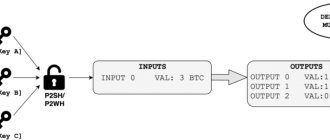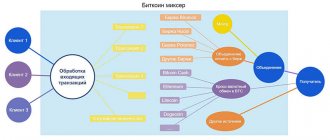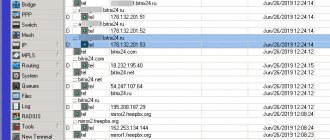What is a node
A node is a server computer connected to the blockchain platform with a running program, for example, a Bitcoin wallet. On the network, it works through the P2P protocol, like a torrent client, exchanging data about operations. The node stores some or all of the information associated with the blockchain. For nodes of this type, there is a map on which you can see the geographical points of the planet with currently active full nodes.
For example, the Bitcoin service is located at Bitnodes. The map shows the concentration of available network nodes found in different countries around the world. A “live” map of nodes is available in real time. Additional tools on the site make it possible to check whether your client accepts incoming connections from other nodes, view the leaderboard, and view the status of the public node.
Nodes in cryptocurrency: what are they in simple words
To make it easier for you to understand what nodes are in cryptocurrency, we will briefly describe the nature of blockchain technology, on the basis of which almost all coins operate. So, blockchain is a decentralized system that stores all information about transactions carried out within it. All electronic information is grouped into interconnected blocks that follow a certain sequence. Since each blockchain has its own cryptocurrency (usually it has the same name as the network itself), the blocks contain information about transfers of internal coins from one user to another. However, this data is not stored in the air. They are contained on hundreds of individual computers with wallets installed for one coin or another. Each such computer is called a node or node.
All nodes are connected to each other using the peer-to-peer (or P2P) protocol. Thanks to this connection, nodes exchange information about network elements and transactions circulating in the cryptocurrency system. It is important that not every node contains absolutely all the information of a particular blockchain. To understand this in more detail, we will look at the existing types of nodes.
Node classification
The main ones are full, lightweight, mining and master nodes.
Full node
A computer connected to the network and fully synchronized with the blockchain system. Stores all important blockchain data with access to it. The main task of a full node is to provide free maintenance to the network of a specific cryptocurrency, download and verify transaction blocks in compliance with the principles of consensus (rules established in the network) of the digital system, as well as “disable” all conflicting blocks and fraudulent financial transactions.
Such a node is a completely independent object, due to which it is possible to make the network as secure and decentralized as possible. The greater the number of nodes in the network, the higher its security. This condition also reduces the risk of access and subsequent management of individual stakeholders to the blockchain system, regardless of the digital platform.
Full nodes have the right to vote on changes to the network, thereby improving the cryptocurrency system. The request is ignored if more than 51 percent of them do not agree with the proposal. If the community does not reach a consensus, it is possible to create chains - forks. For example, Bitcoin Cash.
Lightweight node
A computer with specialized software connected to the blockchain system of a certain cryptocurrency. The main feature of this type of node is that it is impossible to store all the data of a decentralized network; only block headers are allowed to confirm the truth of a particular financial transaction.
A lightweight node is directly dependent on a full node; for this reason, it may periodically have problems confirming transactions that contradict the blockchain consensus. Its launch does not require powerful resources; this also does not have the best effect on security.
Mining node
A full or lightweight node whose purpose is to confirm that the necessary work to create a block has been completed. The accepted common name for such a node is Proof of Work.
To complete the task, miners must belong to full nodes. Otherwise, it is possible to receive data from similar third-party nodes on the network. This is done to determine the current state of the block chain and the necessary parameters for the next blocks.
Participants involved in the process can use their hardware elements - a graphics card, a CPU, a separate integrated mining unit - to solve cryptographic problems. The user who solves the problem first transmits his result to the network for verification by full nodes. When consensus is reached, he is given the opportunity to add a block to the system.
Reference! The work of the miner here is rewarded with a predetermined number of coins in addition to the commission for maintaining the functioning of the network.
Masternode
Unlike a full node, it does not itself have the ability to add blocks to the blockchain. Its sole purpose is to keep records of transactions and verify them. An additional benefit of a masternode is not only to protect the network, but also to receive a share of the rewards for the services provided.
To install and run a node of this type, you will need to block a certain collateral amount of funds. This implies that the node will operate continuously 24 hours, 7 days a week. It is acceptable to open hosting, including on a virtual private server.
DASH is the most famous cryptocurrency that works with the masternode protocol and is supported by thousands of users around the world. Other examples:
- NEO is the Chinese analogue of the Ethereum network;
- ZCoin is a Zerocoin protocol that promotes complete anonymity;
- Crown is a messaging-enabled platform.
What types of nodes are there?
Since we have touched on the topic of network nodes, let's look at what they are. Today, there are 4 types of nodes:
- full;
- lightweight;
- super;
- master.
The category of full nodes includes nodes of the Bitcoin network. They are independent of each other, and save all data on the cryptocurrency blockchain. Their dependence lies in the fact that full nodes operate independently.
Lightweight nodes have fewer powers. Their task is to store tables of contents (headings) of network blocks. They are completely dependent on full nodes.
We wrote about masternodes in the previous section and they have a variety - supernodes, which operate without a wallet and are the end point of the API. At the moment, this type of node is represented in the NEM cryptocurrency.
What tasks do nodes solve?
Different types of nodes solve specific problems, but there are three fundamental positions:
- Following network consensus.
- Providing information about the amount of funds and transactions.
- Storing a copy of confirmed transactions.
In turn, miners create new blocks, light and full nodes send new transactions and can determine the balance of their wallet. The latter, in addition, knows all transactions and stores a copy of the blockchain for security purposes.
Since most networks do not have dedicated servers and there are no centralized governing bodies, users are forced to comply with certain rules, adherence to which is critical to the integrity and security of the cryptocurrency network.
How to start a node
Deployment of a node can be carried out by any user with access to a computer with parameters that meet the minimum technical requirements and a stable high-speed connection to the Internet. For example, for the Bitcoin environment it is:
- desktop or laptop running the latest version of Windows, MacOS X or Linux (for example, Ubuntu);
- 220 GB of free hard disk space with a minimum read/write speed of 90 – 100 MB/s;
- random access memory (RAM) - 2 - 4 GB;
- broadband Internet connection (download speed of at least 400 Kb/s) with unlimited high download limits.
In the case of a full node, the device must operate in constant mode, the minimum value is 6 hours a day.
Installing the client is not fundamentally different from installing regular software on a computer. In the case of Bitcoin, this is Bitcoin Core - the most popular program with support from a wide community of developers. Most of the installation comes down to installing the wallet itself. To download the program, you need to go to the official website and download the latest version of Bitcoin Core.
Reference! A full node can be deployed either on a regular personal computer with the appropriate characteristics or on a virtual server. In addition, you can purchase a specialized separate physical device, of which there are more and more every year.
What is a masternode
This is a fully configured full node that shares rewards with miners for maintaining and supporting the network and offers its computing resources to the system. The most famous cryptocurrency unit that works with the masternode system is Dash. Other examples are Syscoin, PIVX. In a system like NEM, masternodes are called “supernodes” and operate without cryptocurrencies involved via an API endpoint.
The main task of masternodes is to ensure and support increased anonymity of the blockchain platform, where data about blocks and transactions is not recorded. For this reason, most anonymous digital coins require participants who are willing to become independent masternodes.
As of May 2020, 5,000 masternodes are active in the DASH system. Their number definitely affects network security. An increase in the number of masternodes increases the demand for coins and, accordingly, makes an attack on the network unreasonably expensive.
Nodes in cryptocurrency
In order to understand what a node is in a cryptocurrency, you must first understand the operating principle of blockchain technology, which underlies most cryptocurrencies. Roughly speaking, a cryptocurrency blockchain is a decentralized and distributed storage of information about transactions of all existing coins of this cryptocurrency. This entire database is stored in each of the network nodes, which are the user’s computer with the cryptocurrency wallet program installed. These nodes are called nodes .
All nodes connect to each other using peer-to-peer (P2P) protocols and exchange data about blocks and transactions that circulate in the cryptocurrency network.
Back to Contents
How to start a masternode
Creating and launching a masternode can be done by choosing from two options:
- Purchasing space on one of the specialized hosting sites.
- Self-configuring the server.
Installing and running a masternode is a broad and quite complex topic. Algorithm for running a node for DASH:
- We buy a virtual server or specialized hosting or carry out the procedure for setting up our own machine.
- We install the wallet file on your home device and synchronize with the blockchain platform.
- We generate keys using the masternode_genkey and getaccountaddress_0 commands in the Tools menu.
- We encrypt the wallet using a password.
- We make sure to create backup copies on separate media in several copies (you can use a flash drive, external hard drive, or other portable devices).
- We send 1000 DASH to your address. This is approximately 74 thousand dollars at the exchange rate at the end of May 2020.
- We install and configure dashcore on a virtual server; if you purchase specialized hosting, you will not need to install this package.
- Copy the masternode.conf configurator file from the virtual server to the directory with the wallet on your home device.
- Generating the Dash Core wallet key.
Having completed everything necessary, we close the wallet on the local machine - it is needed only for storing funds, when, as a computer with a masternode, it functions completely independently.
The user will be required to monitor system updates on an ongoing basis. Most or less of the software components undergo major changes when new versions are released.
This makes it impossible to use earlier instructions. Up-to-date information on setting up a server and wallet for a masternode is available in the guides on the official DASH forum.
Setting up a masternode on your own server or VPS is an even more complex procedure that requires the user to be able to work with the command line in a Linux operating system. The easiest way is to purchase space on a specialized hosting for masternodes. In this case, it is recommended to use the services of trusted companies.
It should be said that such services offer tariffs that cost almost twice as much as VPS rental. But at the same time, the user does not have to configure the server himself - to launch a masternode, you just need to download the settings file in the form of masternode.conf, and then connect to the wallet on the local machine.
Definition
Let's delve a little into history, the world's first cryptocurrency appeared in 2009, everyone knows that it was Bitcoin. Bitcoin is the most promising and popular investment instrument; it is more or less understandable for a potential user. In fact, a virtual coin consists of five main components:
- virtual currency transactions are carried out from one address to another, for this you only need to obtain a unique cipher and private key;
- operations with virtual coins are a program of scripts, that is, scripts stacked sequentially in a transaction block; they are encrypted between addresses;
- all transactions are added to a block, and they, in turn, are added to the blockchain;
- blockchain is a summary report in which blocks of operations are stored, all of them are interconnected and signed;
- Cryptocurrency is mined by users or miners who, thanks to the power of an electronic computer, solve complex mathematical problems and are responsible for the correctness of information in the blockchain, then receive a reward in the form of virtual coins.
Procedure for canceling a payment in Qiwi made online or in the terminal
Each computer that mines a virtual coin can exchange information with other similar computers, and they form a large network among themselves. This is what is called a node. By the way, translated from English, a node is a node, insofar as the cryptocurrency system is decentralized, it follows that the more nodes in the network, the better.
Please note that you can best understand what a node is if you compare it with a torrent program that constantly exchanges files among network users.
As for virtual currency, its transaction is a part of the file that should go into the block, and then into the blockchain. But the difference with a torrent is that the algorithm for checking the correctness of the data is more complex. And it must be said that Bitcoin is significantly different from the torrent program due to the fact that the protocol here is not limited to the blockchain.
And yet, nodes in cryptocurrency - what are they? Nodes are distinguished between complete and incomplete. We just described the full node above; it stores a copy of the blockchain and has the ability to check the correctness of the operations given in the blocks. An incomplete node is different in that it is used to transfer virtual money as a client, it has no benefit to the blockchain and is easily misled.
It must be said that the blockchain system itself is not ideal, for the simple reason that in order to carry out transactions within it, the entire chain of blocks must be stored. But at the same time, transactions are encrypted, and it is not known which Bitcoin address belongs to whom. In simple terms, users of the transaction block can see all transactions on the account, but only know who its owner is. For example, when paying for a purchase with a bank card, you can see who owns the card; in this case, complete anonymity is guaranteed, but you can get the user’s address and view all his transactions.
This is a big problem for cryptocurrency, so the creators tried to take some steps to get rid of it. When performing transactions, the user must specify a new address in order to distribute funds to different addresses, of which there can be hundreds. But such a precaution is only the initiative of the user himself.
Please note that, contrary to what most people think, Bitcoin is not anonymous, but only impersonal; with each transaction, users leave their traces in the blockchain system, therefore, using a new address each time, it will be able to preserve trade secrets.
In general, in the end, I would like to say that to solve the problem of anonymity, special Bitcoin mixers have been developed that work according to a certain principle. For example, in order to make a transaction anonymously, that is, so that users of the chain cannot identify the sender, you need to contact one of the services, transfer money to him and provide the recipient’s number. The scheme is quite simple: the service receives money from several users at the same time, mixes virtual coins and transfers the required amount to the recipient, but only on its own behalf.
Using a mixer, it will be difficult to determine who transferred virtual coins to whom and how much. Although, on the other hand, the service saves this information. Here it must be said that the emergence of cryptocurrency was due to the fact that all monetary transactions in real currency are easily tracked and can be established by regulatory authorities, thanks to encryption, this problem was solved. But at the same time, another problem has arisen: cryptocurrency is not recognized in the world as a means of payment, although in some countries it is already being considered by the government.
How to earn income from a masternode
To receive income from a masternode, you need to invest your own funds. For example, the minimum quantity to create a node for the DASH cryptocurrency is 1000 coins. The reward for creating a block in the cryptocurrency system under consideration is distributed in the following proportions:
- miner's reward - 45 percent;
- payment to all masternode owners - 45 percent;
- replenishment and support of the Dash system - 10 percent.
More specifically, as of the end of May 2020, the block reward was equivalent to approximately 3.35 DASH. At the same time, there were 4,850 active masternodes operating on the network and each owner of the corresponding node received approximately 0.0007 DASH from each block, which is equivalent to $0.05 at the current cryptocurrency rate of $74.
In Dash, a new block is generated once every 150 seconds on average. This means that masternode owners receive approximately $29 each per day.
The predicted payback time for a masternode in Dash, if we start from the point indicated earlier and focus on the current exchange rate, is approximately 7 - 8 years .
Owners of masternodes can receive significant “unplanned” income when the cryptocurrency rate increases abruptly. For example, users who froze 1,000 DASH in 2020 received 500 to 1,000 percent returns annually over the next two years. And it cannot be excluded that in 2020, masternode buyers will receive no less significant profits due to the promotion and growth of the cryptocurrency market.
More specific information on generating income from a masternode can be obtained on the website masternode.online. The service shows data on the coin: its price, capitalization, trading volume, return on investment (ROI), the number of nodes and the number of coins required to participate in the bet.











